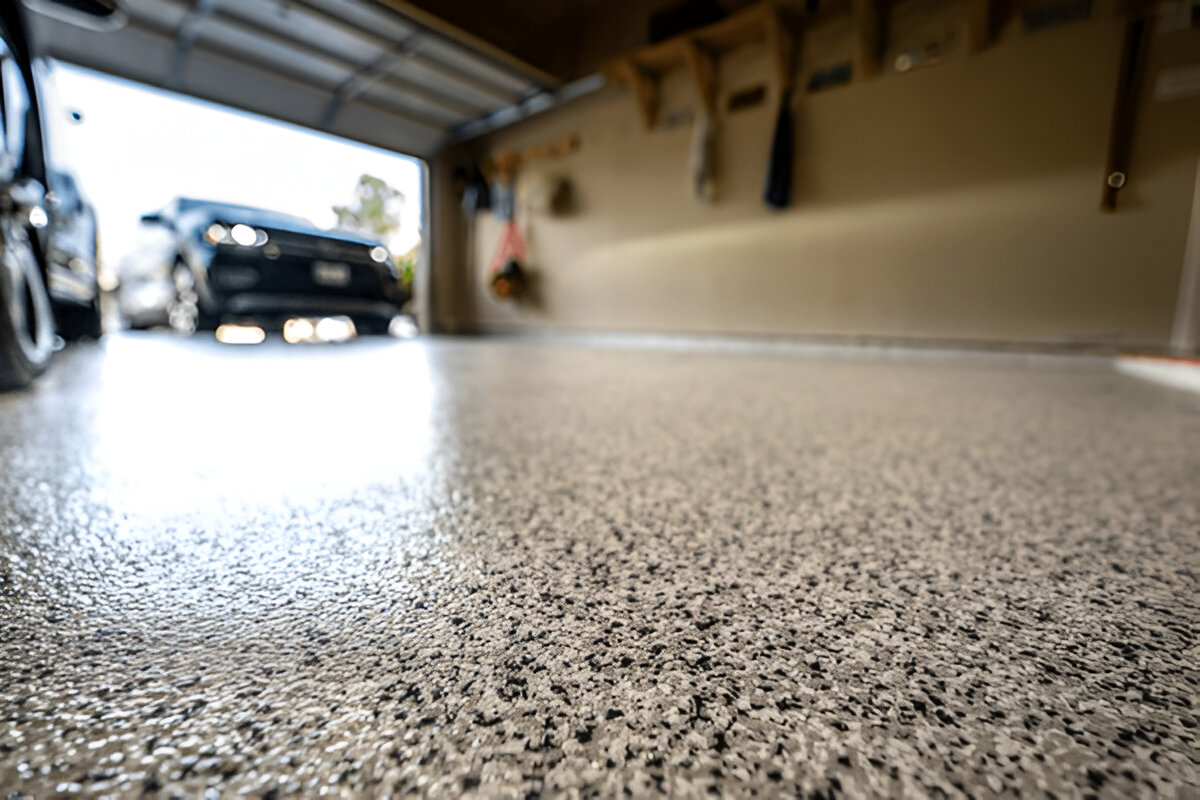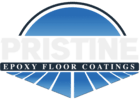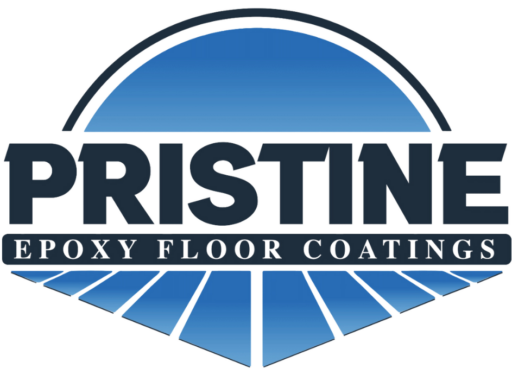
Garage Floor Epoxy vs. Traditional Concrete Coatings: What San Diego Residents Need to Know
San Diego’s unique climate presents specific challenges for garage floor protection. From intense UV exposure to temperature fluctuations, choosing the right coating becomes crucial for maintaining your garage’s integrity and appearance.
Your garage floor faces daily battles:
- Oil and chemical spills
- Heavy vehicle traffic
- Tool impacts
- Temperature variations
- UV radiation
The choice between epoxy and traditional concrete coatings can significantly impact your garage’s longevity and functionality. Each option brings distinct advantages and limitations, particularly relevant to San Diego’s environmental conditions.
Pristine Coatings, a specialist in both epoxy and traditional concrete coating solutions, delivers expert guidance for San Diego homeowners. We understand local climate demands and provide tailored recommendations based on your specific needs. For instance, our epoxy floors are built to last and made to shine, making them an ideal fit for your garage.
This comprehensive guide examines key factors, including:
- Durability comparisons
- Cost considerations
- Installation requirements
- Maintenance needs
- Climate compatibility
Let’s explore these coating options to help you make the best choice for your San Diego garage.
Understanding Garage Floor Coatings
Garage floor coatings are protective layers that safeguard concrete surfaces from everyday damage. These specialized coatings provide a strong defense against various threats, including:
- Chemical spills
- Oil stains
- Heavy vehicle traffic
- Impact damage
- Moisture penetration
What is Epoxy Coating?
Epoxy coating consists of two main components: a polymer resin and a hardening agent. When mixed, these elements create a chemical reaction that forms a rigid, plastic-like material with exceptional bonding properties.
The composition includes:
- Base Layer (Part A): Contains epoxy resin, pigments, and other additives
- Curing Agent (Part B): Catalyst that triggers the hardening process
The bonding process between epoxy and concrete involves several critical steps:
- Surface preparation through grinding or shot blasting
- Opening of concrete pores for better adhesion
- Application of primer (when needed)
- Chemical reaction creating molecular bonds
- Formation of a seamless, non-porous surface
This chemical bonding creates a surface that becomes part of the concrete rather than just sitting on top. The result is a coating that exhibits:
- Tensile Strength: Up to 10,000 psi
- Adhesion: 400+ psi concrete bond
- Thickness: 2-3 millimeters per coat
The curing process typically takes 24-72 hours, during which the epoxy transforms from a liquid state to a solid surface. This transformation creates a protective layer that’s:
- 100% waterproof
- Resistant to most chemicals
- Capable of withstanding heavy impacts
- Available in various colors and finishes
Professional application ensures proper molecular bonding between the epoxy and concrete substrate, maximizing the coating’s durability and performance.
Advantages and Disadvantages of Epoxy Coatings
Epoxy coatings deliver exceptional benefits for garage floors, yet they come with specific considerations San Diego homeowners need to understand.
Key Advantages:
- Superior Durability: Withstands heavy vehicle traffic, resists tire marks and oil stains, prevents concrete deterioration, and maintains appearance for 10+ years with proper care.
- Chemical Resistance: Protects against automotive fluids, repels household chemicals, prevents salt damage, and blocks moisture penetration.
- Low Maintenance Requirements: Dust-free surface, spills wipe clean easily, requires minimal regular cleaning, and reduces concrete dusting.
Important Considerations:
- Installation Challenges: Requires precise surface preparation, temperature-sensitive application process, professional installation recommended, and improper application leads to premature failure.
- Environmental Factors: High temperatures can affect curing, direct UV exposure causes yellowing, humidity impacts installation success, and temperature fluctuations may cause stress.
- Performance Limitations: Potential for chipping under extreme impact, may show wear patterns in high-traffic areas, can peel if moisture trapped underneath, and repairs require professional attention.
San Diego’s climate presents unique challenges for epoxy installations. The intense sunlight can accelerate color changes, particularly in garages with significant sun exposure. Temperature variations between coastal and inland areas affect both installation conditions and long-term performance.
Professional installation addresses these challenges through proper surface preparation, climate-appropriate formulations, and expert application techniques. Quality epoxy systems include UV-resistant top coats, helping maintain appearance despite San Diego’s abundant sunshine.
Exploring Traditional Concrete Coatings
Traditional concrete coatings are a tried-and-true method for protecting garage floors. There are several types of products available in this category, including:
- Acrylic Sealers: Clear or tinted solutions that create a protective film
- Penetrating Sealers: Substances that soak into concrete pores
- Concrete Paint: Specialized paints formulated for concrete surfaces
- Water-Based Coatings: Environmentally friendly options with minimal VOCs
Advantages and Limitations of Traditional Concrete Coatings
Cost-Effective Solutions
- Lower initial investment compared to epoxy systems
- Reduced installation costs
- Minimal specialized equipment requirements
- Affordable reapplication when needed
Application Process
- Single-component systems requiring basic tools
- DIY-friendly application methods
- Quick drying times
- Simple cleanup procedures
Protection Characteristics
- Basic moisture resistance
- Surface-level protection against stains
- Varying degrees of durability based on product quality
- Limited chemical resistance capabilities
Aesthetic Options
- Standard color selections
- Basic finish options (matte, satin, gloss)
- Limited pattern possibilities
- Restricted texture choices
Performance Considerations
- Shorter lifespan than premium coatings
- Regular maintenance requirements
- Susceptibility to heavy wear patterns
- Potential for hot tire pickup
Traditional concrete coatings suit specific garage scenarios:
- Light-duty residential use
- Temporary protection needs
- Budget-conscious projects
- Quick turnaround requirements
These coatings present distinct advantages for San Diego homeowners seeking practical solutions. The application process demands less technical expertise than epoxy systems. A standard concrete sealer can be applied within hours, creating a protective barrier against common garage contaminants.
The moisture protection varies significantly between products. Penetrating sealers offer deep concrete protection, while surface sealers create water-resistant barriers. This versatility allows homeowners to select protection levels matching their specific needs.
Traditional coatings demonstrate limitations under heavy use conditions. They may show wear patterns in high-traffic areas and struggle to resist chemical spills from automotive fluids. The aesthetic options remain basic, typically limited to solid colors without the depth or glossy finish characteristic of epoxy systems.
The durability factor presents trade-offs. While these coatings might require more frequent reapplication, their lower cost and simpler application process balance this consideration. Many San Diego homeowners find this maintenance approach manageable, particularly in garages with moderate use patterns.
Factors Influencing Your Choice Between Epoxy and Traditional Coatings in San Diego
San Diego’s unique climate plays a crucial role in garage floor coating decisions. The city experiences approximately 266 sunny days per year, with UV rays potentially affecting coating durability. Epoxy coatings might show signs of yellowing or fading when exposed to direct sunlight, while traditional concrete coatings often demonstrate better UV resistance.
Climate Considerations:
- Coastal humidity impacts coating adhesion
- Temperature fluctuations affect curing processes
- Salt air exposure requires additional protection
- UV radiation resistance varies by coating type
The intended use of your garage space shapes coating selection:
Heavy Traffic Areas:
- Commercial vehicles
- Workshop activities
- Regular tool usage
- Equipment storage
Light Use Scenarios:
- Personal vehicle parking
- Limited foot traffic
- Occasional storage
- Minimal mechanical work
Maintenance Preferences: Epoxy vs. Traditional Coatings
Epoxy Maintenance Requirements:
- Deep cleaning every 6-12 months
- Immediate spill cleanup
- Periodic resealing (3-5 years)
- Professional repairs when needed
Traditional Coating Care:
- Regular sweeping
- Monthly cleaning
- Annual reapplication possible
- DIY repairs feasible
Budget considerations extend beyond initial installation costs:
Long-term Investment Analysis:
- Epoxy: $3-12 per square foot
- Traditional coatings: $1-4 per square foot
- Installation labor costs
- Maintenance expenses
- Expected lifespan of coating
Cleaning Ease Comparison:
Epoxy Surfaces:
- Resistant to most chemicals
- Wipes clean with minimal effort
- Prevents stain absorption
- Maintains appearance longer
Traditional Coatings:
- Requires stronger cleaning agents
- More frequent cleaning needed
- Higher porosity affects cleanliness
- Shorter aesthetic lifespan
The selection process should account for specific environmental factors unique to San Diego neighborhoods. Coastal areas face different challenges compared to inland locations. Professional assessment helps determine optimal coating choices based on location-specific conditions and usage patterns.
Making an Informed Decision for Your Garage Flooring Solution in San Diego
Selecting the right garage flooring solution requires careful consideration of your specific needs and circumstances. Here’s a practical decision-making framework to guide your choice:
Assessment Checklist:
- Usage Pattern: Consider how you plan to use your garage. Will it be primarily for parking vehicles, conducting workshop activities, storing items, or exposed to chemicals?
- Environmental Factors: Take into account the environmental conditions that may impact your garage. Is there direct sunlight exposure? Are there significant temperature fluctuations or moisture levels? If you’re near the coast, salt air exposure might also be a factor.
- Investment Considerations: Evaluate the financial aspects of your decision. What are the initial installation costs? How much will maintenance expenses be in the long run? Will this investment have an impact on your property’s value? And how long do you expect the flooring to last?
Decision Matrix:
Choose Epoxy If You Need:
- Maximum durability
- Chemical resistance
- Custom aesthetic options
- Long-term value
Choose Traditional Coating If You:
- Have budget constraints
- Need quick application
- Plan short-term property ownership
- Require simple maintenance
San Diego’s unique climate patterns affect coating performance differently throughout the year. The coastal environment’s salt content, combined with UV exposure, can impact both epoxy and traditional coatings. Consider scheduling a professional assessment to evaluate your garage’s specific conditions and receive tailored recommendations for your space.
Additional Resources From Pristine Coatings
Ready to transform your garage floor? Pristine Coatings offers expert guidance through:
Free Consultation Services
- Professional assessment of your garage floor condition
- Customized coating recommendations
- Detailed cost estimates
Educational Materials
- Download our Garage Floor Coating Guide
- Watch installation videos
- Browse our project gallery
Expert Support
- Direct access to coating specialists
- Maintenance tips and best practices
- Product-specific guidance
Contact us at (619) 454-3968 for personalized assistance with your garage floor coating needs.
FAQs (Frequently Asked Questions)
Garage floor epoxy offers long-lasting performance against scratches and stains, resistance to impacts and chemicals, and easy maintenance due to its dirt-repellent properties. In contrast, traditional concrete coatings such as sealers and paints are simpler to apply, budget-friendly, but generally less effective against heavy impacts and chemical spills.
San Diego’s climate, particularly its UV exposure, can impact the integrity of coatings. Epoxy may fade or chip under high temperatures, while traditional coatings may offer varying levels of moisture protection. It’s essential to consider these factors when choosing the right coating for your garage.
Maintenance preferences play a crucial role in your decision. Epoxy coatings typically require less upkeep due to their dirt-repellent nature, while traditional coatings may need more frequent reapplication or touch-ups depending on their durability.
Yes, traditional concrete coatings often present more budget-friendly choices for homeowners who are cost-conscious. However, it’s important to weigh the initial cost against the long-term durability and maintenance costs associated with each type of coating.
While epoxy coatings provide many benefits, they also come with risks such as chipping or peeling if not applied correctly. Additionally, high temperatures can affect the integrity of the epoxy, and prolonged UV exposure may lead to fading over time.
For trusted information and solutions regarding garage floor coatings, you can visit Pristine Coatings. They provide valuable resources that can help homeowners make informed decisions about their garage flooring projects.

